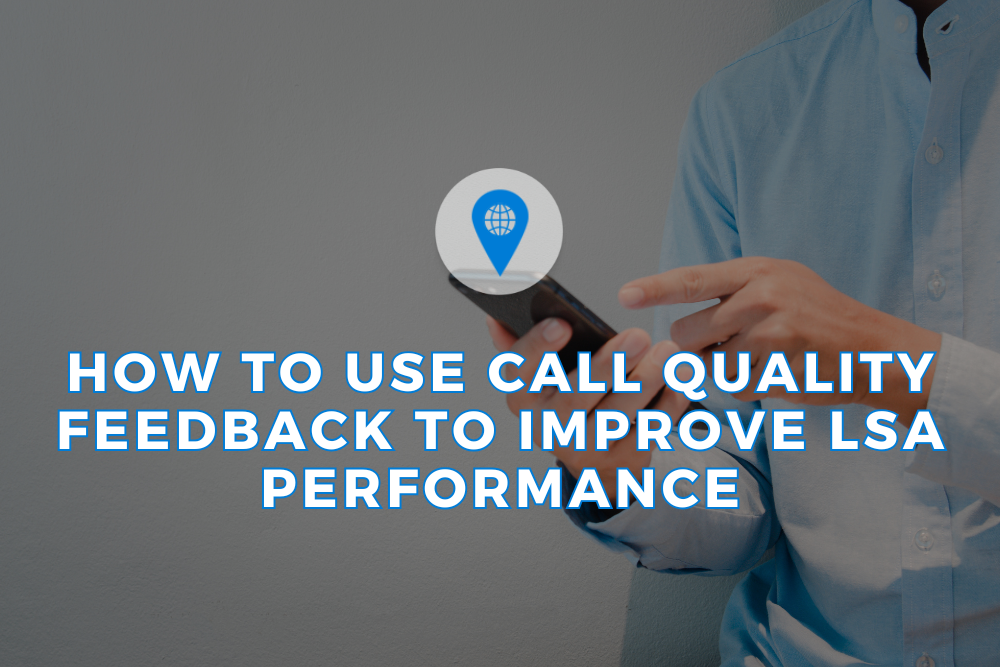How to Use Call Quality Feedback to Improve LSA Performance
- Published: October 20, 2025

Google Local Services Ads (LSAs) are one of the most powerful tools for generating local leads. But while most businesses focus on profile optimization, reviews, and job types, they often ignore one of the most important—and overlooked—factors in long-term LSA success: call quality feedback.
Google tracks how your business handles LSA leads. From missed calls and unanswered messages to poor customer experiences, your call performance directly impacts your ad ranking, visibility, and lead volume.
In this guide, we’ll explain what call quality feedback is, how Google uses it to shape your LSA presence, and what actionable steps you can take to turn every call into a competitive advantage.
What Is Call Quality Feedback in LSAs?
Call quality feedback refers to how your business handles and converts the calls that come through your LSA ads. Google monitors several indicators to assess this, including:
- Call answer rate
- Call duration
- Lead engagement (booked vs. missed)
- Customer reviews and complaints
- Post-call feedback from users (when available)
- Call handling patterns over time
Google uses this data to help determine your LSA ranking, trustworthiness, and eligibility for continued lead delivery.
Why Call Quality Matters for LSA Rankings
While budget and proximity matter, Google wants to show top-performing businesses to its users. That means if you’re consistently missing calls, hanging up too quickly, or delivering a poor customer experience, Google may:
- Reduce your ad visibility
- Lower your position in search results
- Decrease the number of leads you receive
- Temporarily pause your ads
- Flag your profile for further review
The takeaway? Call handling is just as important as your profile setup or review count.
6 Ways to Improve Your Call Quality Feedback (and LSA Performance)
1. Answer Every Call—Fast
Google tracks how many LSA calls go unanswered or hit voicemail. A high number of missed calls signals that you’re not responsive, which can hurt your ranking.
Tips:
- Set up a dedicated line or call center for LSA leads
- Use call forwarding or a virtual receptionist service
- Assign someone to monitor incoming calls during business hours
- Extend your hours if possible to capture after-hours demand
2. Don’t Rush or Cut Calls Short
Google considers calls that are too short (e.g., under 10–15 seconds) a negative signal—especially if the customer doesn’t feel heard.
What to do:
- Let the caller speak fully before responding
- Ask follow-up questions to understand their needs
- Never dismiss or rush leads, even if they’re outside your immediate scope
Even if it’s not a perfect match, handle every call professionally. That caller may still leave a positive review or refer others.
3. Mark Leads as “Booked” in Your Dashboard
One of the most important (but frequently skipped) steps is to mark successful calls as “booked” in your LSA dashboard. Google uses this as a direct performance metric.
Why it matters:
- Shows Google you’re converting leads effectively
- Reinforces your quality score
- Helps with lead tracking and dispute resolution
Make this a regular part of your post-call workflow.
4. Monitor and Review Call Recordings
LSA records all incoming calls (with user consent) so you can listen and evaluate performance.
Use these recordings to:
- Identify trends in missed or poor-quality calls
- Train your staff on better customer handling
- Catch and resolve service-related complaints
- Pinpoint issues with tone, language, or response time
Pro tip: Use call recordings as coaching tools for team meetings or onboarding.
5. Respond to All Messages Promptly
If your LSA profile is enabled for messaging (text/chat leads), Google expects a fast reply. Delayed or ignored messages can damage your ranking.
Best practices:
- Enable notifications for new LSA messages
- Use pre-written replies to speed up your response
- Assign responsibility for responding to a specific team member
Google may even display your average response time—so make it count.
6. Ask Satisfied Callers to Leave a Review
Great call experiences create happy customers—and happy customers leave great reviews. These, in turn, boost your rankings and reinforce trust.
After a successful call:
- Send a polite text or email asking for a review
- Provide a direct link to your Google Business Profile
- Mention how much reviews help you improve and grow
More reviews = stronger credibility + better ad position.
How to Track Your Call Quality Performance
Use your LSA dashboard and Google reports to review:
- Number of calls received per week
- Percentage of calls answered vs. missed
- Average call duration
- Booking conversion rates
- Disputed leads and reasons
- Call recordings for quality assurance
Review this data weekly, and track improvements over time.
What to Avoid
- Letting LSA calls go to voicemail repeatedly
- Disputing too many leads without clear reasons
- Transferring calls without context or courtesy
- Using aggressive or unprofessional tone
- Ignoring negative feedback or poor reviews
Remember, every interaction reflects your business—and Google is watching.
Conclusion: Your LSA Call Quality Is Your Competitive Advantage
In a crowded local market, the way you answer the phone can be the difference between ranking #1 or getting buried. Call quality feedback isn’t just a technical metric—it’s a direct reflection of how well you treat potential customers.
By improving your response time, refining your call handling, and consistently delivering a great experience, you’ll not only convert more leads—you’ll also rise in LSA rankings and unlock better long-term ROI.
